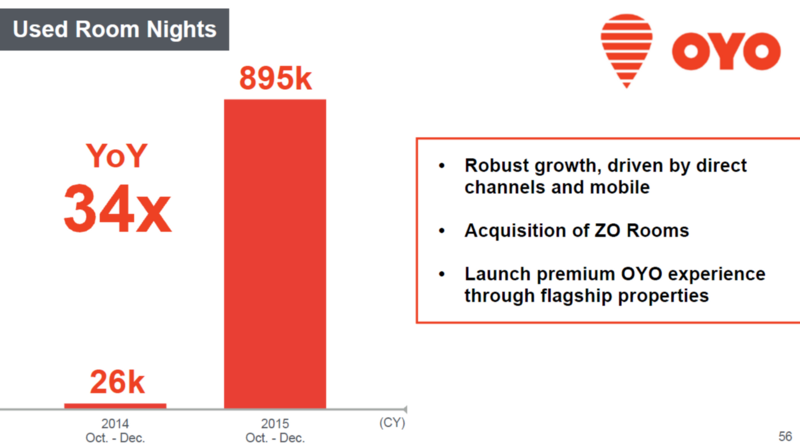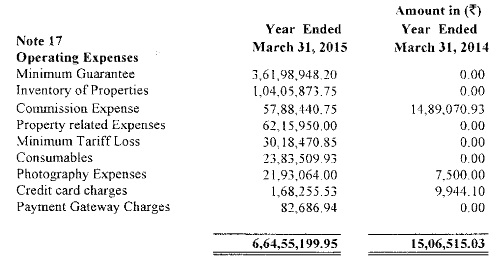Update 1: Ritesh Agarwal, Founder – OYO Rooms, has challenged the article in a recent email clarifying the company’s position. You can read his response along with few interesting questions that remain unanswered here.
Last week, SoftBank released its quarterly report that contained an update summarizing the state of Oyo Rooms, the Indian startup in which it had famously invested $100m late last year.
The slide contained the above graph claiming that Oyo Rooms has grown 15X year-on-year in the last one year.
Ritesh Agarwal, the CEO of Oyo Rooms, released a statement claiming that this 15X growth implied that the company has delivered 2.3 million booked room-night transactions in the first quarter of 2016 – this translates to more than 766,000 rooms a month.
All of this would have been fine if not for one little fly in the ointment.
A little less than a year back, Oyo had released a similar statement claiming that it was booking “400,000 rooms a month”!
Clearly, Oyo was either “exaggerating” the numbers then or they are doing so now.
What makes this even more interesting is a similar graph that SoftBank had inserted in an earlier report where Oyo was said to have grown a mind-boggling 34X times year-on-year with 895,000 rooms per quarter (approximately 10,000 rooms per night) for the Oct-Dec 2015 quarter.
Graph from SoftBank quarterly report — Jan 2016
But this graph is interesting for one more reason — rather than “booked room nights”, it speaks of “used room nights”.
Therein lies the tale of how Oyo is, in all probability, the startup equivalent of a Ponzi scheme!
Let’s take a step back to figure out how this scheme operates.
What exactly does Oyo Rooms do?
“When I heard Ritesh (Oyo) speak, I thought how a tea seller like me didn’t think of setting up a hotel chain” — Prime Minister Modi, Jan 2016
Contrary to this widely-believed notion, Oyo is not a “hotel chain”. Despite Ritesh’s constant attempts to position his company as “India’s largest hotel chain” comparable to the likes of ITC, Oyo is at its essence merely a hotel aggregation platform which delivers customer leads to low/mid-budget hotels. Oyo owns exactly zero hotels. Oyo operates exactly zero hotels on behalf of others. So Oyo is as much a hotel chain as MakeMyTrip is an airline company.
Oyo does do one thing somewhat uniquely — the hotels to which it routes customer leads to are co-branded with the Oyo brand. This ostensibly guarantees customers predictability and standardized room quality.
How does Oyo make money?
Traditionally, this works on the basis of commissions — a MakeMyTrip or ClearTrip kind of agent will walk to a hotel and tell him “I’ll be an agent, give me commission”. Sure, says the hotel owner. If the hotel has a good room booking system, then the agency will set it up so that they can request for room availability at any time, and they will negotiate a rate that they can use for different days. If the hotel does not, the agency will attempt to “block” rooms for certain days, adjusting the blocks on a regular basis so that the hotel can continue to accommodate walk-ins while the agency manages to book their inventory too. The commission for a booking is typically a percentage of the room rate and ranges from 15% to 30% of the total.
One big problem with this model, at least from the perspective of agents like Oyo, is that the hotel owner sees this as a purely commercial/transactional type of arrangement — a hit-or-miss “race to the bottom” business model with progressively tighter margins given the fact that there is zero stickiness and the hotel owner can tie up with any number of agents simultaneously.
To secure an initial mandate from the hotel owners around using the Oyo brand, they offered sweeteners in the form of “soft loans” (ostensibly to refurbish or improve hotel infrastructure — supply new mattresses, equip them with WiFi, new paint jobs etc) but the broad model was still the same.
Enter “Minimum Guarantee”.
To ward off competition and to build a deeper relationship with hotels, Oyo came up with a “minimum guarantee” offer.
The minimum guarantee model involves the agent committing a certain amount of business to the hotel and only taking a cut on the incremental revenue. So let’s say a hotel has 10 rooms. The agent pre-blocks, say 5 rooms and guarantees the hotel owner with a certain sum of money per year for those rooms. Let’s say Rs. 4 lakhs. The agent now has to fill this inventory — if he is unable to drive at least Rs. 4 lakhs of revenue for these rooms and say does only Rs. 3 lakhs instead, he has to pay the hotel owner the difference of Rs. 1 lakh out of his pocket. If he is able to generate, say Rs. 6 lakhs of revenue for these rooms, the hotel owner gets to first keep Rs. 4 lakhs and the incremental Rs. 2 lakhs is shared between the hotel and agent usually in a 70–30% split or thereabouts. So at the end of all this, the agent gets Rs. 60,000 (30% of Rs. 2 lakhs).
This is a great model for the hotel as it de-risks his inventory risk and shifts the burden to the agent.
However, this wasn’t enough for Oyo to win the game.
Competitors soon cottoned on and started offering minimum guarantees to hotels and the market became increasingly crowded and noisy.
That’s when Oyo took the step that took them down the Ponzi rabbit-hole.
Take a look at the note below extracted from Oyo’s financial statement. Do you notice anything unusual?
Extract from Oyo Rooms annual report for FY 2014–15
Minimum guarantee is listed as an operating expense!
What does this mean?
Well, ideally there should have only been one operating cost item related to minimum guarantees — “Minimum tariff loss” that recognizes the shortfall the Oyo would need to pay out of its own pocket. But the fact that Minimum guarantee itself is an operating expense implies that Oyo was not only offering such guarantees, it was actually paying these amounts up-front!
While this might seem like a harmless thing that buys hotel loyalty, it is, in fact, a dangerous step that leads to all kinds of perverse incentives and adverse behavior.
Unraveling the Ponzi
The hotel owners were delighted to get this upfront minimum guarantee — not only were they derisked from unused inventory, they got paid in advance which greatly helped working capital requirements.
But it created two specific types of perverse incentives for hotel owners.
Firstly, now that they were paid in advance, they were under no pressing obligation to maintain the hotel to the standards that Oyo aspired towards — after all, even if they gave poor-quality rooms to Oyo’s customers, what is the worst that Oyo could do? They couldn’t terminate the agreement or even if they did, they wouldn’t get their investment back. So, a cursory search of any of the hotel review sites will show you a great number of complaints from consumers who got stuck with pathetic rooms that they booked through Oyo.
Secondly, the minimum guarantee was an unexpected bonus in another way. Since Oyo rarely picked up the entire inventory of a hotel and because the hotels themselves hardly had any type of dashboard that would show details of walk-ins, hotel owners could give out rooms that Oyo has already paid for to their direct customers! While in theory Oyo monitored inventory usage, in practice, they had close to zero visibility. This would often lead to situations where customers who would book rooms on Oyo finding the hotel refusing to honor the booking by claiming that they were overbooked. Again, one can see numerous examples of customer complaints of this nature on the hotel review sites.
This essentially meant that both the benefits— standardized room quality and predictability — that Oyo touted as its core value propositions were completely frittered away. Oyo had basically shot itself in the foot.
While this was a bad thing, there was something even worse.
Oyo would buy rooms at say Rs. 1,999 per night — the only way it could make any money was if it sold the same room to a customer for Rs.2,000 or more. Not only did Oyo discover that this was easier said than done, especially during lean and off-peak seasons where uptake was very low but they also realized (rather belatedly?) that these rooms have zero inventory value! If a night passed without being used, the entire Rs.1,999 was down the drain with nothing to show for it.
But if they could sell a room even for Rs. 1 per night, they could at least count this as a “used room night”. Of course, this wouldn’t make much of a difference to their revenue figures but what if they could bandy this as a metric that is shown growing up and to the right?
This imperative kicked off the fire sale — not only did Oyo offer rooms at severely discounted prices (losing as much as Rs. 1,000 on each room night as per some estimates), they literally gave away rooms for next to free! There are well-traveled stories that Oyo grew so desperate to shore up this metric that their representatives went out to local colleges and handed out coupons in the parking lot to any student couple who could use the room for as little as one hour for a session of “joint studies”! This one-hour type of booking also meant that they could potentially turn over multiple bookings per day and further boost their used room nights count (of course, some hotels refused to honor such bookings while others weren’t so puritanical).
Now, if you are thinking that all of this is fine (maybe unethical on multiple fronts but not illegal) but how exactly does it constitute a Ponzi?
Let’s take a step back and revisit what the metric “booked room night” means. It implies a transaction where a hotel room night was booked. But nowhere does this guarantee or explicitly say that the room was booked by an actual customer. So a minimum guarantee paid upfront is also technically a room booking in itself!
So we have a potential situation where Oyo could be selling zero rooms but could still tout a huge count for booked room nights because…they are buying the rooms! This essentially means that they could be touting traction, not on the basis of SKUs that they sell but those that they — a bizarre turn of events that gives the phrase “buying traction” a completely new spin! This also means that forget about having negative gross margins, we could potentially be looking at a situation where a product has a negative selling price!
Admittedly, there is no way to know for sure whether the numbers reported by Oyo fall in this hoary category but the point is that Oyo is now reporting vanity metrics that can stage-managed and gamed in any which way they choose and quite easily at that. While vanity metrics are bad for a number of reasons, in most cases, they are at least directionally correct but in this case, there is hardly any correlation.
But this is only half the story.
Part 2 of this deep dive will attempt to delve into the other half — the imperatives behind Oyo’s Ponzi and the larger issues that merit scrutiny.
Disclaimer: The opinions mentioned above are solely of Author. The article was originally published by the author here.
Update 1: Ritesh Agarwal, Founder – OYO Rooms, has challenged the article in a recent email clarifying the company’s position. You can read his response along with few interesting questions that remain unanswered here.



